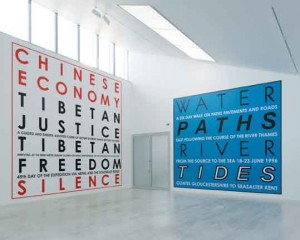« Features
Kettle’s Whistle: The Walked and the Drawn Line
When the eminent professor Arnold Bode initiated Documenta in 1955, his primary goal was to show the ‘Entartete Kunst’ (degenerated art) erstwhile banned from his country by giving movements such as Fauvism, Cubism, Surrealism and fundamentally anything remotely abstract the first opportunity to be viewed in post-war Germany. It was clearly a challenging task, and it’s no surprise that the subsequent editions, despite their orientation towards a more contemporary discourse, never quite deviated from this paramount concept. Documenta 2 (1959) was an earnest if not austere presentation of the art that has characterized the first half of the century, with intermittent flashes on a group of post-1945 artists working within that tradition, while Documenta 3 (1964), admittedly a slightly more adventurous affair, had nevertheless in guest curator Werner Haftmann a strenuous advocator of the importance of pre-war modernism over the present.
The first proper generational turnover-it is a well-documented fact-occurred on the occasion of Documenta 5 (1972), when Harald Szeemann imported the forms and attitudes that had rocked Bern three years earlier, letting people such as Vito Acconci, Joseph Beuys, Christo, Edward Ruscha and La Monte Young taking center stage. This drastic reversion, coupled with a rather complex political scenario and an increasing appetite for new horizons, established the philosophy that pretty much accompanied Documenta for the next two decades. Aided and abetted by structural components like a clean-cut venue, a five-year gap between one exhibition and the next (an indisputable guarantee of authority), and the impeccable intellectual framework that constituted its foundation, Documenta was well equipped to navigate the insidious waters of trend- and name-discovering without compromising its commencing relevance. Maybe Documenta wasn’t at the helm of the ship, but it was definitely in the crow’s nest shouting, “Land, ho!”
With the benefit of temporal distance, it is safe to say that the at-the-time much-criticized Documenta 13 organized by Roger M. Buergel and Ruth Noack in 2007, with the unexpected combination of young guns that included Johanna Billing, Hu Xiaoyuan and Churchill Madikida and old hands such as Jorge Oteiza, Grete Stern and Poul Gernes, yielded a twist of events destined to set the ball rolling for another curatorial micro-revolution. The gap between past and future was significantly narrowed, and the idea that talent scooping could be achieved by traveling with a crystal ball in one hand and a history of art manual in the other, set an example soon to be followed by the more receptive and imaginative spirit. ‘Lost and found’ surveys started appearing in many publications, trans-generational exhibitions like Mark Wallinger’s “The Russian Linesman” (Hayward Gallery, London, 2009) and Massimiliano Gioni’s “10,000 Lives” (Gwangju Biennale, 2010) proliferated, with even the impermeable world of art fairs eventually taking notice (the “Back to the Future” section of Artissima in Turin being one of the most poignant episodes). Difficult as it is to predict how long it will last before running into inevitable exhaustion or co-option, this new course so far has had the merit of proposing a model that, although vulnerable on paper to the reintroduction of the confusing parameters that characterized the 1980s, when people were trading Kandinskys for Clementes, it creates a genuine chance to appreciate the line of continuity that has defined art making over the centuries.
The latest successful chapter in the series is the improbable pairing of Joseph Mallord William Turner, the ultimate landscape painter, and Hamish Fulton, the pioneer of walking art, at Turner Contemporary in Margate, Kent, U.K. The two artists share a history with Kent, Turner having lodged in the 1880s in the very same location where the art center is now situated, and Fulton being a long-time resident of the area. But the real intriguing geographical common denominator is about an inclination for wandering around and a fascination for the elements. Fulton’s diagrams and Turner’s posthumous informative titles underscore how they have crisscrossed the continent, occasionally hitting on the same spots. Both comprehended that any attempt to produce a visually realistic record of their observations would have been impossible, opting instead for a more evocative approach that would leave plenty of room to imagination, with Fulton dropping one-liners, log entries and notes, and Turner drawing storms and other meteorological phenomena with a degree of abstraction that must have startled many of his peers in the 19th-century English art world.
Finally, they have both been labeled as ‘romantic,’ a definition that if it comes across as restrictive for Turner, it is totally misplaced for Fulton, whose endeavors, which include climbing Mount Everest or walking 106 miles without a break on English country roads, carry implications that go far beyond fairy-tale idealism. Fulton’s tendency to synthesize, or in certain instances almost trivialize, his remarkable achievements through postcard pictures and billboard signs indicates a conviction that the original experience cannot be fully re-created, a philosophy that no doubt inhibited Turner even in those moments when his confrontations with the task of capturing natural wonders in the limited space of a canvas were successful. There is a line between Turner and Fulton, and it doesn’t matter much if one decided to draw it and one to walk it.




































